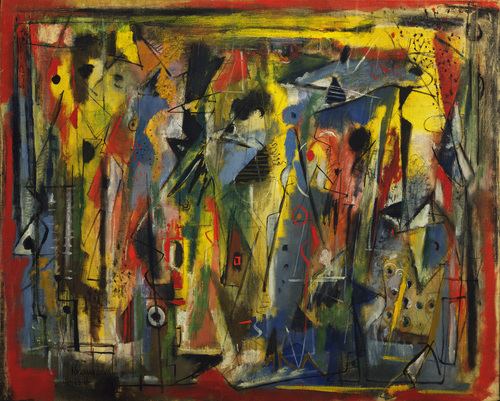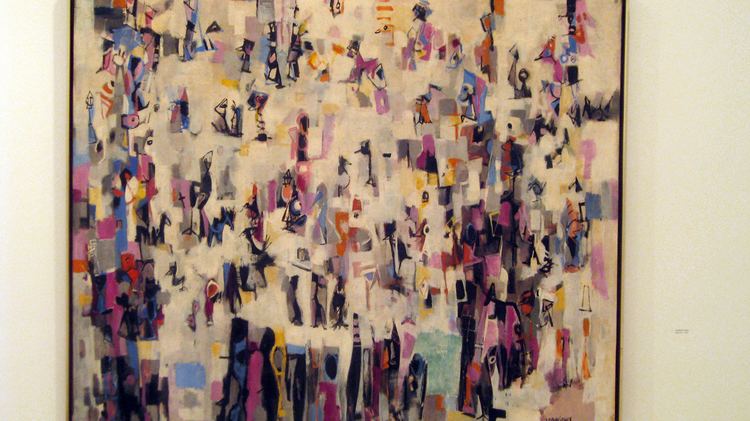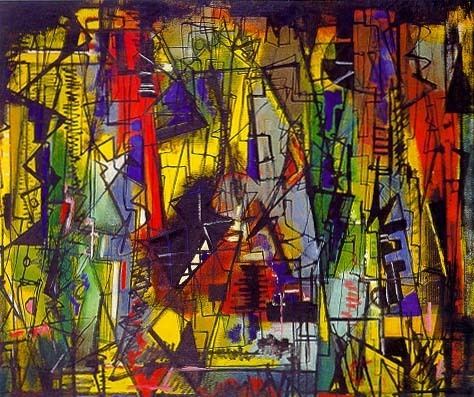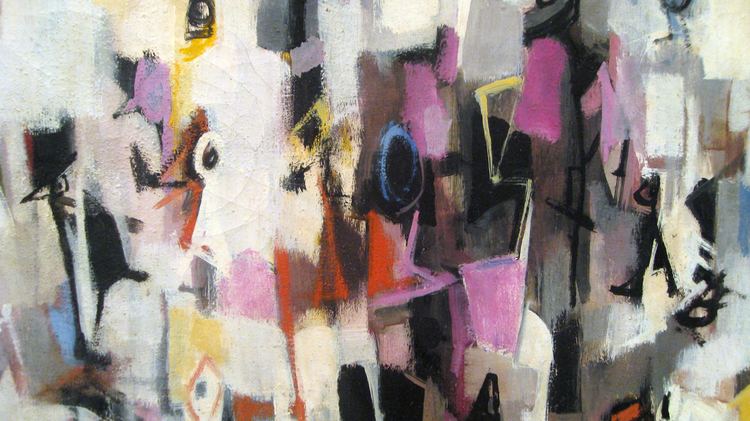Nationality American Role Artist Name Norman Lewis | Known for Painting | |
 | ||
Died August 27, 1979, New York City, New York, United States Education Columbia University (1933–1935) Artwork Phantasy II, The Soup Kitchen, Untitled Awards Guggenheim Fellowship for Creative Arts, US & Canada | ||
Revisiting abstract artist norman lewis via cbs sunday morning
Norman W. Lewis (July 23, 1909 – August 27, 1979) was an American painter, scholar, and teacher. He is associated with Abstract Expressionism and also used representational strategies to focus on black urban life and his community's struggles. Lewis was African-American, of Bermudian descent.
Contents
- Revisiting abstract artist norman lewis via cbs sunday morning
- Norman lewis and the politics of abstraction new
- Early life and career
- Later work
- Spiral
- References

Norman lewis and the politics of abstraction new
Early life and career

Norman Wilfred Lewis was born in Harlem, New York to Bermudian parents. Always interested in art, he had amassed a large art history library by the time he was a young man. A lifelong resident of Harlem, he also traveled extensively during the two years that he worked on ocean freighters. An important early influence was the sculptor and teacher Augusta Savage, who provided him with open studio space at her Harlem Community Art Center. He also participated in WPA art projects, alongside Jackson Pollock, among others.

Lewis began his career in 1933, with earlier mostly figurative work. He at first painted what he saw, which ranged from Meeting Place (1930), a swap meet scene, and The Yellow Hat (1936), a formal Cubist painting, to Dispossessed (1940), an eviction scene, and Jazz Musicians (1948), a visual depiction of the bebop that was being played in Harlem.

He also painted social realism, painting with "an overtly figurative style, depicting bread lines, evictions, and police brutality."

Lewis said he struggled to express social conflict in his art, but in his later years, focused on the inherently aesthetic. "The goal of the artist must be aesthetic development," he told art historian Kellie Jones, "and in a universal sense, to make in his own way some contribution to culture."

Norman Lewis was the only African- American artist among the first generation of Abstract Expressionists. As was expressed in the segment about him on the March 20, 2016 television show "Sunday Morning" (http://www.cbsnews.com/news/reappraising-the-art-of-norman-lewis/), his work was overlooked by both White and African-American art dealers and gallery owners. He did not fit into either category perfectly. As was recently noted in a catalogue accompanying a major retrospective of Lewis's paintings this omission seem clear enough.
Later work
In the late 1940s, his work became increasingly abstract. His total engagement with abstract expressionism was due partially to his disillusionment with America after his wartime experiences in World War II. It seemed extremely hypocritical that America was fighting "against an enemy whose master race ideology was echoed at home by the fact of a segregated armed forces." Seeing that art does not have the power to change the political state that society was in, he decided that people should develop their aesthetic skills more, instead of focusing on political art. Tenement I (1952), Harlem Turns White (1955), and Night Walker No. 2 (1956) are all examples of his style. Twilight Sounds (1947) and Jazz Band (1948) are examples of his interest in conveying music.
One of his best known paintings, Migrating Birds (1954), won the Popular Prize at the Carnegie Museum's 1955 Carnegie International Exhibition, the New York Herald-Tribune calling the painting "one of the most significant of all events of the 1955 art year." His signature style in those decades included repetitive ideographic or hieroglyphic elements that allowed Lewis to incorporate narrative sequences into his paintings.
His later work includes Alabama II (1969), Part Vision (1971), and New World Acoming (1971), as well as a series called Seachange done in his last years. In 1963 he was a founding member of the SPIRAL Group.
Although represented by galleries, and the recipient of many awards and good reviews, his work did not sell nearly as well as the other Abstract Expressionists he exhibited with, such as Mark Tobey or Mark Rothko. His body of work included paintings, drawings, and murals. Mostly he supported himself, and later his wife and daughter, through teaching. In 1972, he received a grant from the Mark Rothko Foundation and a Fellowship from the National Endowment for the Arts. In 1975 he received a Guggenheim Fellowship.
He died unexpectedly on August 27, 1979, in New York.
Spiral
Lewis was a founding member of Spiral, a group of artists and writers who met regularly that included Charles Alston, Romare Bearden, and Hale Woodruff. The group met "to discuss the potential of Black artists to engage with issues of racial equality and struggle in the 1960s through their work." Despite Spiral's short existence, it was very impactful in the art world, as it called attention to many issues of racial inequality that existed at the time.
For instance, due to Spiral and other groups' continuous protest against the 1968 controversial exhibit "Harlem on My Mind" in the Metropolitan Museum of Art, Black people became more visible in the art world. Before this exhibition, the Met did not feature anything on New York's cultural powerhouse neighborhood Harlem. Harlem is known for its art and music, but this exhibition featured no self-representation of that from the neighborhood. Instead, it was composed of photographs that a non-Harlemite photographer took of the people who lived there. Many people protested that more Black culture should be exhibited, instead of this kind of zoo exhibition, where there is an us (the affluent white dominant audience) versus them (the Harlemites).
